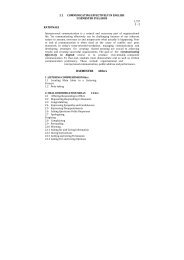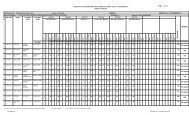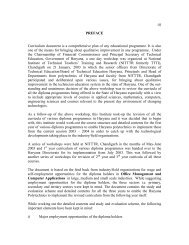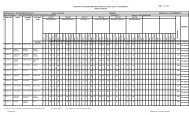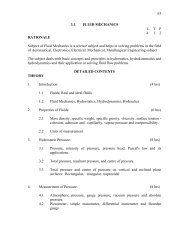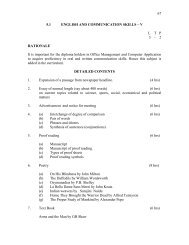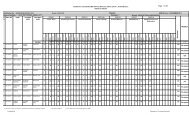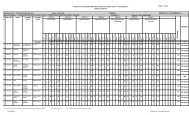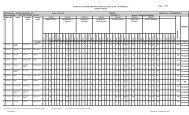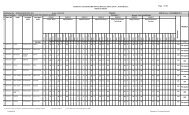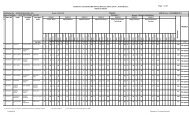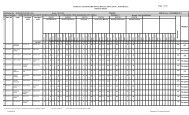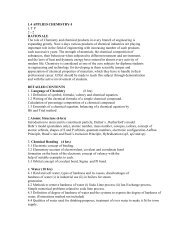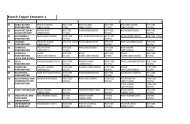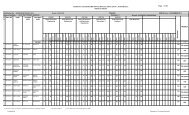I.I SEMESTER SYLLABUS - hsbte
I.I SEMESTER SYLLABUS - hsbte
I.I SEMESTER SYLLABUS - hsbte
Create successful ePaper yourself
Turn your PDF publications into a flip-book with our unique Google optimized e-Paper software.
Rationale<br />
I.I <strong>SEMESTER</strong> <strong>SYLLABUS</strong><br />
COMMUNICATING EFFECTIVELY IN ENGLISH<br />
Interpersonal communication is a natural and necessary part of organizational<br />
life. Yet, communicating effectively can be challenging because of our inherent<br />
nature to assume, overreact to and misperceive what actually is happening. Poor<br />
communication or lack of communication is often cited as the cause of conflict<br />
and poor teamwork. In today’s team-oriented workplace, managing<br />
communication and<br />
1<br />
L T P<br />
3 – 2<br />
developing strategies for creating shared meaning are<br />
crucial to achieving results and creating successful organizations. The goal of<br />
the Communicating Effectively in English course is to produce civic-minded,<br />
competent communicators. To that end, students must demonstrate oral as well as<br />
written communication proficiency. These include organizational and<br />
interpersonal communication, public address and performance.<br />
Objectives of Course in Communicating Effectively in English for the First<br />
Year (I & II Semesters) are:<br />
* Understanding how communication<br />
works<br />
* Gaining active listening and responding<br />
skills<br />
* Understanding the importance of body<br />
language<br />
* Acquiring different strategies of reading<br />
texts<br />
* Increasing confidence by providing opportunities for oral and written<br />
expressions
DETAILED CONTENTS FOR FIRST <strong>SEMESTER</strong><br />
I <strong>SEMESTER</strong><br />
1. COMMUNICATION SKILLS 6 hrs<br />
2<br />
48 HRS<br />
1.1 Verbal and Non-verbal Communication<br />
1.2 Process of Communication<br />
1.3 Barriers to Communication; Overcoming Strategies<br />
1.4 Listening and Speaking Skills and Sub-Skills<br />
2. Spoken English-Introduction, Features of Spoken English<br />
(Note: This module is only for practice. This should not be included in the final<br />
examination)<br />
2. DEVELOPING ORAL COMMUNICATION SKILLS 8 hrs<br />
2.1 Greeting, Starting a Conversation<br />
2.3 Introducing Oneself<br />
2.4 Introducing Others<br />
2.5 Leave Taking<br />
2.6 Thanking, Wishing Well<br />
2.7 Talking about Oneself<br />
2.8 Talking about Likes and Dislikes<br />
3. GRAMMAR AND USAGE 12 hrs<br />
3.1 Punctuation<br />
3.2 Articles-a, an, the<br />
3.3 Framing Questions<br />
3.4 Verbs-Classification: Main Verb, Auxiliary Verb, Transitive & Intransitive<br />
Verbs, Phrasal Verbs<br />
3.5 Word Formation<br />
4. WRITING SKILLS 10 hrs<br />
4.1 Writing Paragraphs<br />
4.2 Picture Composition<br />
5. READING SKILLS 12 hrs<br />
5.1 Vocabulary Enhancement<br />
5.2 Techniques of Reading: Skimming, Scanning, Intensive and Extensive Reading<br />
NOTE: The Reading Skills of the learners (along with vocabulary enhancement)
will be through reading thematic articles/essays and/or stories.<br />
Section I<br />
3<br />
Theoretical Concepts of Communication Skills<br />
Unit 1<br />
Communication Skills<br />
Unit 2 Listening and Speaking Skills and Sub-Skills 24<br />
Unit 3 Pronunciation 29<br />
Section II<br />
Oral Communication Skills<br />
Unit 1 Starting a Conversation 57<br />
Unit 2 Introducing Oneself and Others 58<br />
Unit 3 Greeting and Taking Leave 62<br />
Unit 4 Wishing Well 65<br />
Unit 5 Expressing Thanks 68<br />
Unit 6 Talking about Oneself 69<br />
Unit 7 Expressing Likes and Dislikes 71<br />
Section III Reading<br />
Skills<br />
Unit 1 Who is the Dumbest Animal in the World 77<br />
Unit 2 The Happy Guy Discovers the Cause of Memory Loss:<br />
Defective Glue 86<br />
Unit 3 Himalaya: Tantric Phuchen Lamas 94<br />
Unit 4 Samoa, Heart of Polynesia 100<br />
Unit 5 A Guide to Gas Powered RC Cars 11<br />
Unit 6 Life’s a Beach: A Shore Theme in Your Outdoor Space 117<br />
Unit 7 Spanish Tapas: The Small Plate with Big Flavour 124<br />
Unit 8 Himalaya: Cultural Experience—Spiti 134<br />
Unit 9 Paperless Payroll: Going Green Saves More Than Trees 149<br />
Section IV<br />
Writing Skills
Unit 1 Mechanics of Developing a Paragraph 158<br />
Unit 2 Strategies of Developing a Paragraph 165<br />
Unit 3 Integrated Language Tasks 169<br />
Unit 4 Picture Composition 173<br />
4<br />
Section V<br />
Grammar and Usage<br />
Unit 1 Punctuation 180<br />
Unit 2 Articles 188<br />
Unit 3 Word Formation 192<br />
Unit 4 Framing Questions 199<br />
Unit 5 Verbs 210<br />
Unit 6 Transitive and Intransitive Verbs 214<br />
Unit 7 Phrasal Verbs 219<br />
Appendix: List of New Lexical Items and Expressions 222<br />
Sample Question Paper I 242<br />
Sample Question Paper II 248
5<br />
1.2 INDUSTRIAL ORGANIZATION<br />
RATIONALE<br />
L T P<br />
Hrs/week 4 2 -<br />
The purpose of this subject is to develop an understanding of basic concepts of<br />
business, commerce and industry. The course includes concept of trade, commerce,<br />
and industrial organisations.<br />
DETAILED CONTENTS<br />
1. Concept of business, trade, commerce and industry, importance of commerce<br />
in industry, organization of business. The essential requisites for business<br />
success; Social responsibility of business<br />
(10 hrs<br />
2. Types of ownership of Industrial Organization (22 hrs<br />
a) Sole proprietorship<br />
b) Hindu undivided family<br />
c) Partnership<br />
d) Co-operative Societies<br />
e) Joint stock companies<br />
f) Form of public sector undertakings<br />
3. Foreign Trade: Introduction to export and import (6 hrs)<br />
4. Transport – Land, air and water etc. merits and demerits of each (6 hrs)<br />
5. Insurance – marine, fire, life etc (8 hrs)<br />
6. Negotiable Instruments: Bills of exchange, promissory notes, cheques, drafts (6<br />
hrs)<br />
7. Operation of various bank accounts – Endorsement and crossing functions of<br />
commercial banks, credit cards, use of ATM<br />
(6 hrs)<br />
Note: At least two visit to industry / field in a<br />
semester<br />
RECOMMENDED BOOKS<br />
1. Fundamentals of Business Organization and Management by YK Bhushan,<br />
Sultan Chand and Sons, New Delhi<br />
2. Organization and Management by Kulshreshta, Sahitya Bhawan, Agra
6<br />
3. Business Organization and Management by CB Gupta, Sultan Chand and<br />
Sons, New Delhi<br />
TUTORIAL ASSIGNMENTS<br />
1. Prepare a bill of exchange, Promissory Notes, Cheques and Drafts<br />
2. Prepare a partnership deed and explain how to get it registered<br />
3. Explain various fire and life insurance policies<br />
4. Explain various types of transport systems with their merits and demerits<br />
5. Make a comparative study of the features of Joint Stock Company and<br />
co-operative societies<br />
6. Uses of credit cards and ATM
7<br />
1.3 ESSENTIALS OF MANAGEMENT<br />
RATIONALE<br />
L T P<br />
Hrs/week 4 2<br />
-<br />
The study and understanding of principles of management concepts and different<br />
functions of management is very essential for the students of this diploma. The subject<br />
includes elementary knowledge of concepts of management viz. planning, organizing,<br />
staffing, directing and controlling. The basic knowledge of various functions of<br />
management will enable the students to take effective steps for performing various<br />
office duties.<br />
DETAILED CONTENTS<br />
1. Introduction (12 hrs)<br />
1.1 Concept, scope and importance of management<br />
1.2 Role, objectives and functions of management<br />
1.3 Principles of management<br />
2. Planning (10 hrs)<br />
2.1 Concept and importance<br />
2.2 Planning process<br />
2.3 Meaning and importance, purpose, mission, objectives, short term, long<br />
term and strategic planning, policies and procedures<br />
2.4 Meaning, importance and process of decision making<br />
3. Organizing (12 hrs)<br />
3.1 Concept and importance<br />
3.2 Concepts, advantages and disadvantages of formal, informal, functional,<br />
line, staff and committee types of organization<br />
3.3 Concepts, importance and difference between delegation and<br />
decentralization<br />
4. Staffing (16 hrs)<br />
4.1 Concept, need and importance of training
8<br />
4.2 Introduction to on-the-job, off-the-job and<br />
continuing training<br />
5. Directing (10 hrs)<br />
5.1 Concept and<br />
importance<br />
5.2 Leadership – concept, importance, types of leaders, qualities of<br />
good leader<br />
5.3 Motivation –meaning, types and<br />
importance<br />
5.4 Communication – concepts, importance, process and types of<br />
communication, barriers to communication<br />
6. Controlling (8 hrs)<br />
6.1 Concept importance and process of<br />
control<br />
6.2 Monitoring and evaluation –<br />
concepts only<br />
Note: Visit an industrial Organization and<br />
preparation of report<br />
Teacher may invite experienced managers from industries and other<br />
organizations to deliver extension lectures. The teacher should plan and<br />
prepare appropriate tutorial assignments for the students. Students may be<br />
encouraged to prepare and present the case studies<br />
RECOMMENDED BOOKS<br />
1. Principles and Practice of Management by Prasad LM; Sultan Chand and Sons,<br />
New Delhi<br />
2. Management Theory and Practice by Gupta CB, Sultan S Chand & Co., New<br />
Delhi<br />
3. Management Concepts and organization Behahaviour by NK Sahni, Kalyani<br />
Publishers<br />
(2003) New<br />
Delhi<br />
4. Fundamentals of Business Organization and Management by Bhushan<br />
YK; Sultan S Chand & Co., New Delhi
5. Principles of Management – an Analysis of Managerial Functions by<br />
Koontz O Donnel<br />
McGraw Hill Book<br />
Company<br />
9<br />
6. Essentials of Management by Singh and Chhabra; Kitab Mahal, New Delhi<br />
7. Principles and Practice of Management by TN Chhabra; Dhanpat Rai and Sons,<br />
New Delhi<br />
8. Principles and Practice of Management by SP Ganguli, Chatterjee Publishing<br />
Concern<br />
9. Management Principles and Practice by R Srinivasan and SA Chunawalla;<br />
Himalaya<br />
Publishing House, Bombay,Delhi and Nagpur<br />
10. Managing People Effective, Managerial Experiences by Dr ML Bhasin; Global<br />
Business Press. – “ OM” Series<br />
11. Principles and Practice of Management by CB Gupta, National Publishing<br />
House, New Delhi<br />
TUTORIAL ASSIGNMENTS<br />
1. Comparing the qualities of good leader and effective manager<br />
2. Methods of training<br />
3. Management v/s administration<br />
4. Elements in decision making process
10<br />
1.4 BUSINESS ECONOMICS<br />
RATIONALE<br />
The objective of this subject is to make familiar the students with the basic concepts<br />
of economics prevailing in business world to make a strong formal base for their<br />
career. Economics leads to optimum and equal distribution of different factors of<br />
production. The success and survival of the business depends upon optimum use of<br />
limited resources. They will learn about consumption, production, market, wages,<br />
rent, interest, profit and various aspects of managerial economics.<br />
DETAILED<br />
CONTENTS<br />
1. Basic Concepts (8<br />
hrs) Utility, goods, value, price, wealth, human wants and classification<br />
of wants in to necessities, comforts and luxuries<br />
2. Consumption (10<br />
hrs) Concept of utility and marginal utility, laws of diminishing marginal<br />
utility and equi-marginal utility, indifference curves, demand and laws of<br />
demand elasticity of demand and its measurement, point elasticity and arc<br />
elasticity<br />
3. Production (10 hrs)<br />
Characteristics of factors of production, land, labour, capital, organization<br />
and enterprise. Efficiency and division of labour, capital formation and<br />
function of entrepreneur, laws of returns to scale, law of diminishing returns<br />
(variable proportions)<br />
4. Market (10 hrs)<br />
Meaning, size and types. Perfect competition and general principles of price<br />
determination<br />
under perfect competition<br />
5. Wages (8<br />
hrs) Meaning, nominal and real wages, demand and supply theory of wages
6. Rent (8<br />
11<br />
hrs) Meaning, Recardian theory of rent<br />
7. Interest (6 hrs)<br />
Meaning, gross and net interest, demand and supply (of capital) theory of<br />
interest<br />
8. Profit (4 hrs)<br />
Meaning, gross and net profit<br />
RECOMMENDED BOOKS<br />
1. Principles of Economics by Jain; Gupta and Narang<br />
2. Modern Economics Theory by KK Dewett, Vikas Publication, New Delhi<br />
3. Micro Economics by TR Jain, Vikas Publications, New Delhi<br />
4. Business Economics by Mithani DM; Himalaya Publications<br />
TUTORIAL ASSIGNMENTS<br />
1. Elasticity of demand and factors which determine elasticity of demand<br />
2. Application of law of diminishing marginal utility<br />
3. Uses of indifference curve analysis<br />
4. Explain income, substitution and price effect<br />
5. Examples of inferior goods and giffon goods<br />
6. Explain factors of production<br />
7. Labour its types and importance<br />
8. Factors governing the efficiency of labour<br />
9. Compare capital and wealth
1.5 ORGANIZATIONAL BEHAVIOUR - I<br />
12<br />
RATIONALE<br />
The main objective of this course is to familiarize the students with basic<br />
concepts of human behaviour, principle practices and organizational processes on a<br />
behavioural dimensions<br />
DETAILED<br />
CONTENTS<br />
1. Individual Behaviour (10 hrs)<br />
Meaning and concept of individual behaviour, basis of individual<br />
differences, abilities,<br />
learning aptitudes, attitudes value measurement<br />
2. Personality (15 hrs)<br />
Nature and determinants of personality, self concept and defensive<br />
behaivour, perception,<br />
perceptual selection and distortion<br />
3. Self Development (14<br />
hrs) Understanding of self, transactional analysis<br />
Macland Theory of achievement, power and affiliation<br />
4. Motivation (25 hrs)<br />
Meaning and types of motivation, theories of motivation, Maslow’s<br />
need, hierarchy,<br />
Herzberg two factor theory, theory X and Y, Vrooms theory of expectation,<br />
RECOMMENDED BOOKS<br />
1. Management concept and organisational behaviour by Dr. MARKETING Sahni<br />
2. Organisational behaviour by Shri Sashi Gupta and Rosy Joshi, Kalyani<br />
Publication, New Delhi<br />
3. Organizational Behaviour by Luthans Fred, McGraw Hills<br />
4. Organizational Behaviour by LN Prasad, Sultan Chand and Sons, New Delhi<br />
5. Organization Behaviour by SP Robbins, Prentice Hall of India, New Delhi<br />
6. Organizational Behaviour by Uma Saharan, Tata McGraw Hill, New Delhi<br />
7. Human Relations and Organization Behaviour by RS Diwidhi, MacMillan
India Ltd, New Delhi.<br />
13<br />
8. Human Behaviour at Work by Keith Davis, Tata McGraw Hill, New Delhi<br />
9. Organizational Theory and Behaviour by RA Sharma, Tata McGraw Hill, New<br />
Delhi<br />
10. Organizational Processes by Udai Pareek, Oxford and IHB, New Delhi<br />
TUTORIAL ASSIGNMENTS<br />
1. Study of Johari window<br />
2. Narrate few incidents of perceptual distortions<br />
3. Study of defensive behaviour of the students in the class<br />
4. Comparative study of need hierarchy theory and two factor theory<br />
5. Comparative study of McGrann’s theory “X” and “Y”<br />
6. Study of individual behaviour of a classmate by assigning Weightage to<br />
each aspect of individual behaviour<br />
7. Identify the personality of 5 classmates<br />
8. Understand self; a complete report in 500 words<br />
9. Discuss advantages and disadvantages of various theories of motivation of merit.
14<br />
1.6 INDEPENDENT STUDY AND PRESENTATION<br />
L T P<br />
- - 5<br />
RATIONALE<br />
This course has been introduced for the first time to have noval experience with the<br />
aim to develop communication (written and oral) ability of students and habit of<br />
self study which will make them self learners. This is not a subject for which there is<br />
external theory examination.<br />
Through this course, the students will have the opportunity of self and independent<br />
study by searching literature. They will prepare study papers and presentations. The<br />
teachers will provide topics for self-learning.<br />
There will be internal and external assessment for the work done and performance.<br />
The topics must be chosen from the curriculum. Situational approach should be<br />
added through case studies relating to actual life of the individual, family,<br />
organisation etc. in Indian or international context.<br />
Following criterion for assessment will be both in internal and external evaluation:<br />
Preparation of study paper - 40%<br />
Presentation and via - 60%<br />
SUGGESTED<br />
TOPICS<br />
1. Communication and barriers in Communication<br />
2. Types of communication and importance of non-verbal communication<br />
3. Different types of ownership of Business Originations<br />
4. Operation of various bank Accounts and negotiable instruments<br />
5. Insurance<br />
6. Social responsibility of Business Management<br />
7. Role, Objective and functions of Management<br />
8. Planning Process<br />
9. Leadership<br />
10. Motivation<br />
11. Management by Objectives( MBO )<br />
12. Market (Perfect competition and price determination under perfect<br />
competition<br />
13. Wages<br />
14. Factors of Production<br />
15. Personality<br />
16. Self Development
1.7 GENERAL WORKSHOP PRACTICE – I & II<br />
15<br />
RATIONAL<br />
Manual abilities to handle engineering materials with hand tools need to be<br />
developed in the students. They will be using different types of<br />
tools/equipment in different shops for fabrication purposes. Besides developing<br />
the necessary skills, the students will appreciate the importance of quality and<br />
safety measures.<br />
DETAILED CONTENTS<br />
Note: 1. The students are supposed to come in proper workshop<br />
dress prescribed by the institute. Wearing shoes in the<br />
workshop(s) is compulsory. Importance of safety and cleanliness,<br />
safety measures and upkeep of tools, equipment and environment<br />
in each of the following shops should be explained and practiced.<br />
The students should prepare sketches of various tools/jobs in their<br />
practical Notebook.<br />
2. The shops to be offered in I and II semester may be decided<br />
at polytechnic level<br />
3. The students should be taken to various shops (not included in<br />
the curriculum) in the polytechnic in batches and should be given<br />
knowledge of the various machines/equipment. Such as<br />
machine shop, foundry shop, sheet metal shop, etc.<br />
4. Students of Diploma in Chemical Engineering will undergo Shops 1<br />
to 6 only<br />
Following seven shops are being proposed:<br />
1. Carpentry shop<br />
2. Fitting and plumbing shop<br />
3. Welding shop<br />
4. Paint shop<br />
5. Forging and sheet metal shop<br />
6. Electric shop<br />
7. Electronics Shop
16<br />
1. Carpentry Shop<br />
1.1 Introduction to various types of wood, carpentry tools - their<br />
identification with sketches. Different types of wood joints.<br />
1.2 Simple operations viz. hand sawing, marking, planning<br />
1.3 Introduction and sharpening of wood working tools and practice of<br />
proper adjustment of tools<br />
1.4 Demonstration and use of wood working machines i.e. band saw, circular<br />
saw, rip saw, bow saw and trammels. Universal wood working machine<br />
and wood turning lathe<br />
1.5 Making of various joints (Also draw the sketches of various wooden<br />
joints in the Practical Note Book)<br />
a) Cross lap<br />
joint<br />
b) T-lap joint<br />
c) Corner lap joint<br />
d) Mortise and tenon<br />
joint<br />
e) Dovetail joint<br />
f) Prepare a file handle or any utility items by wood turning lathe<br />
2. Fitting and Plumbing Shop<br />
2.1. Introduction to fitting shop, common materials used in fitting<br />
shop, description and demonstration of various types of work-holding<br />
devices and surface plate, V-block<br />
2.2 Demonstration and use of simple operation of hack-sawing,<br />
demonstration of various types of blades and their uses<br />
2.3 Demonstrate and use of all important fitting shop tools with the help of<br />
neat sketches (files, punch, hammer, scraper, taps and dyes etc.)<br />
2.4 Introduction of chipping, demonstration on chipping and its<br />
applications.<br />
Demonstration and function of chipping tools.<br />
2.5 Description, demonstration and practice of simple operation of hack<br />
saw, straight and angular cutting.
17<br />
2.6 Demonstrations, description and use of various types of blades - their uses<br />
and method of fitting the blade.<br />
2.7 Introduction and use of measuring tools used in fitting shop like: Try<br />
square, Steel rule, Measuring Tape, Outside micrometer, Vernier Caliper<br />
and Vernier Height Gauge<br />
2.8 Description, demonstration and practice of thread cutting using taps and<br />
dies<br />
2.9 Plumbing: Descriptions and drawing of various plumbing shop tools,<br />
Safety precautions. Introduction and demonstration of pipe dies, Pipe<br />
holding devices, Demonstration and practice of Pipe Fittings such as<br />
Sockets, Elbow, Tee, Reducer, Nipple, Union coupling, plug, Bend, Float<br />
valves and Taps<br />
Job:<br />
Job:<br />
Job:<br />
Job:<br />
Job:<br />
Job:<br />
Cutting and filing practice on a square of 45 X 45 mm 2 from MS flat<br />
Angular cutting practice of 45 0 (on the above job)<br />
Preparation of stud (to cut external threads) with the help of dies<br />
(mm or BSW)<br />
Drilling, counter drilling and internal thread cutting with Taps<br />
H-Fitting in Mild steel (ms) square<br />
Pipe cutting practice and thread cutting on GI Pipe with pipe dies<br />
3. Welding Shop<br />
3.1 Introduction to welding, type of welding, common materials that can<br />
be welded, introduction to gas welding equipment, types of flame,<br />
adjustment of flame, applications of gas welding. Welding tools and safety<br />
precautions<br />
3.2 Introduction to electric arc welding (AC and DC), practice in setting<br />
current and voltage for striking proper arc, precautions while using<br />
electric arc welding. Applications of arc welding. Introduction to polarity<br />
and their use<br />
3.3 Introduction to brazing process, filler material and fluxes; applications<br />
of brazing. Use of solder. Introduction of soldering materials<br />
3.4 Demonstrate and use of the different tools used in the welding shop<br />
with sketches. Hand shield, helmet, clipping hammer, gloves, welding lead,<br />
connectors, apron, goggles etc.
18<br />
3.5 Demonstration of welding defects and Various types of joints and<br />
end preparation<br />
Job: Preparation of cap joint by arc welding<br />
Job: Preparation of Tee joint by arc welding<br />
Job: Preparation of single V or double V butt joint by using<br />
Electric arc welding<br />
Job: Brazing Practice. Use of Speltor (on MS sheet<br />
pieces) Job: Gas welding practice on worn-out and<br />
broken parts<br />
4. Paint Shop<br />
Introduction of painting shop and necessity. Different types of paints.<br />
Introduction of powder coating plant and their uses.<br />
Job: Preparation of surface before painting such as cleaning, sanding,<br />
putty, procedure and application of primer coat, and painting steel item.<br />
Job: Painting practice by brush on MS sheet<br />
Job: Practice of dip painting<br />
Job: Practice of lettering: Name plates / Sign board<br />
Job: Polishing and painting on wooden and metallic surfaces<br />
Job: Practical demonstration of powder coating<br />
5. Forging and sheet metal shop<br />
Introduction to forging, forging tools, tongs, blowers/pressure blowers,<br />
hammers, chisels, punch, anvil, swag-block etc. Forging operations.<br />
5.1 Forge a L hook or Ring from MS rod 6 mm φ<br />
5.2 Forge a chisel and give an idea of hardening and tempering<br />
5.3 Lap joint with forge welding<br />
5.4 High Strength Steel (HSS) tools – forging of Lathe shaper tools like sidetools<br />
and V-shape tools<br />
5.5 Making sheet metal joints<br />
5.6 Making sheet metal trey or a funnel or a computer chassis<br />
5.7 Preparation of sheet metal jobs involving rolling, shearing, creasing,<br />
bending and cornering<br />
5.8 Prepare a lap riveting joint of sheet metal pieces
19<br />
6. Electric Shop<br />
6.1 Demonstration of tools commonly used in Electric Shop<br />
6.2 Safety precautions , electric shock treatment<br />
6.3 Demonstration of Common Electric material like: wires, fuses, ceiling<br />
roses, battens, cleats and allied items<br />
6.4 Demonstration of Voltmeter, Ammeter, Multimeter and Energy meter<br />
Job: Wiring practice in batten wiring, plastic casing-capping and conduit<br />
Job: Control of one lamp by one switch<br />
Job: Control of one lamp by two switches Job: Control of one bell by<br />
one switch Job: Assemble a Tube light<br />
Job: Dismantle, study, find out fault, repair the fault, assemble and<br />
test domestic appliances like electric iron, electric mixer, ceiling<br />
and table fan, tube-light, water heater (geyser) and desert cooler<br />
Job: Laying out of complete wiring of a house (Single-phase and<br />
Three- phase)<br />
7. Electronics Shop<br />
7.1 Identification, familiarization, demonstration and use of the<br />
following electronic instruments:<br />
a) Multi-meter digital<br />
b) Single beam simple CRO , function of every knob on the<br />
front panel<br />
c) Power supply , fixed voltage and variable voltage, single output<br />
as well as dual output.<br />
7.2 Identification , familiarization and uses of commonly used tools; active<br />
and passive components; colour code and types of resistor and<br />
potentiometers<br />
7.3 Cut, strip, join and insulate two lengths of wires/cables (repeat with<br />
different types of cables/ wires)<br />
7.4 Demonstrate and practice the skill to remove components/wires by<br />
unsoldering<br />
7.5 Cut, bend, tin component, leads, inserts. Solder components e.g.<br />
resistor, capacitor, diodes, transistors on a PCB<br />
7.6 Wiring of a small circuit on a PCB/tag strip involving laying, sleeving and<br />
use of identifier tags
20<br />
7.7 Demonstrate the joining (or connecting) methods/mounting and<br />
dismantling method, as well as uses of the items mentioned below:<br />
a) Various types of plugs, sockets, connectors suitable for<br />
general- purpose audio video use.<br />
Some of such connectors e.g.<br />
2 and 3 pin mains plug and sockets, Banana plugs, sockets and<br />
similar male and female connectors and terminal strips.<br />
b) Various types of switches such as: normal/miniature toggle, slide,<br />
push button piano key, rotary, SPST, SPDT, DPST, DPDT, band<br />
selector, multi-way Master Mains Switch.<br />
7.8 Exposure to modern soldering and de-soldering processes (Field visits)<br />
7.9 De-solder pump, remove and clean all the components and wires from a<br />
given equipment, a PCB or a tag strip.



